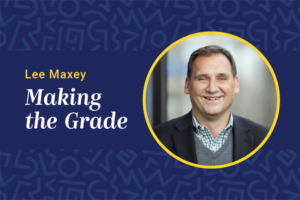
There’s a disconnect between the way higher ed delivers its product and what adult learners want.
by Lee Maxey
October 3, 2019
 According to the National Center for Education Statistics, in 1970, 2.57 million 18- to 19-year-old students were enrolled in degree-granting postsecondary institutions compared with 767,000 students age 35 years and older. In 2020, the NCES projects those same groups will total 4.24 million and 3.28 million, respectively. A number of things — including recessions, downsizing and the rapid development and application of technology — have served as a catalyst for people 35 and older enrolling in postsecondary study. But not every 30-something wants (or needs) to enroll in a degree program to acquire skills they need to do their job, gain a promotion or switch fields. There’s a critical opportunity for higher education to serve students beyond the stereotypical college-age learner.
According to the National Center for Education Statistics, in 1970, 2.57 million 18- to 19-year-old students were enrolled in degree-granting postsecondary institutions compared with 767,000 students age 35 years and older. In 2020, the NCES projects those same groups will total 4.24 million and 3.28 million, respectively. A number of things — including recessions, downsizing and the rapid development and application of technology — have served as a catalyst for people 35 and older enrolling in postsecondary study. But not every 30-something wants (or needs) to enroll in a degree program to acquire skills they need to do their job, gain a promotion or switch fields. There’s a critical opportunity for higher education to serve students beyond the stereotypical college-age learner.
Some universities and colleges see the opportunity; others don’t. Compounding the challenge for nontraditional learners are institutions of higher ed teaching with an agrarian paradigm in mind. Even schools offering adult programming largely structure courses and schedules by semester, whereas businesses operate on a quarterly calendar driven by fiscal-year budgeting and strategic plans. Simply put, there’s a disconnect between the way higher ed delivers its product and what adult learners want.
With a new mindset, universities and colleges could be a far greater resource for working adults and their employers. Schools that adapt to meet the needs of businesses may find an untapped dividend. For example, 15 years ago business training was a $60 billion industry; today pundits peg that industry’s value at more than $360 billion. Clearly, there’s a lot of companies and employees invested in developing workers’ skills, and higher education could carve out a piece of this by rethinking learning.
Some universities have already begun pursuing flexible options for educating traditional and nontraditional learners. Unity College in Maine, for example, bills itself as the first college in the U.S. to base its curriculum on “a framework of sustainability science.” The school’s approach educates students to help an earth and environment in crisis.
I spoke with Unity College President Melik Peter Khoury about the school’s new TERRAIN program, in which students are traditional first-year and transfer students who will acquire expeditionary learning across Maine with full-time faculty and professionals in lieu of simply taking five independent classes to fill a semester. With TERRAIN, students apply the skills they learn so they can solve real-world problems.
In addition to Unity College’s flagship campus, which is mostly made up of 17- to 22-year-olds, the school offers an online learning program, which Khoury referred to as “distance education.” With its distance education program, Unity serves up five-week undergraduate terms and eight-week graduate cycles. According to Khoury, even the online programs are experiential, with field work tailored for the working professional in mind. The school also offers “low-residency” certificate courses, meaning students spend a few days or weeks at Unity College learning about, say, biology, and then visit a sometimes exotic locale to interact with the environment they’ve studied in the classroom.
Like Khoury, Rovy Branon, vice provost for the University of Washington Continuum College, told me his institution is changing the traditional definition and understanding of education. “We’re not an old-school extension or continuing education program,” he said. “We’re a comprehensive part of the educational ecosystem in Seattle, and we now serve more than 55,000 learners annually ranging in age from eight to 98.”
One way that Continuum College is changing education for learners is with its Career Accelerator program. Working professionals have four paths to obtaining credentials that will advance their careers. Learners can earn, for instance, a data analytics certificate via: 1) a self-paced, online approach; 2) an accelerated classroom path lasting two months; 3) an online group class lasting five to nine months; or 4) a part-time class meeting once a week for nine months.
Additionally, to accommodate employers and employees, the college also offers some programs that allow for enrollment any time.
Both Khoury and Branon said partnerships forged with business and government have been key to re-engineering their respective programs and curriculum. They acknowledged they want to work with companies and government agencies with workers who need varied, changing skills. Some learners may require a bachelor’s degree, others may want a certificate, and some employees seek microcredentials.
Branon’s approach has been creating a corporate advisory board for each certificate offered and pairing that board with faculty who have cutting-edge, industry knowledge. If, for instance, line workers at Boeing need a course in composite manufacturing, the team comes together to decide what that course should look like; eventually, other manufacturers can enroll too.
“We solicit an employer’s perspective,” Branon said. “By offering certificates, we gain approval at a speed that keeps up with industry; gaining approval for degrees is a much longer road.”
Khoury and Branon acknowledged that academia doesn’t always make partnering easy. They recommend CLOs seek out people in charge of outreach or a dean or vice provost overseeing adult or distance education. These are people often trying to adapt calendars and curriculum to forge unconventional programs, open enrollments and institute rolling admissions. If a CLO articulates a desired outcome, school officials say they’re open to listening.




